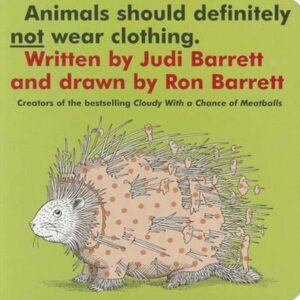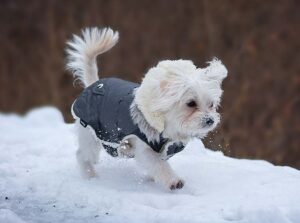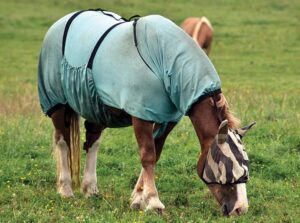Problem-solving, Object inquiry skills
Toddlers participate in a humorous book sharing on the sizes and uses of familiar clothing for people worn by animals.

Animals Should Definitely Not Wear Clothing by Judi Barrett


[Invite 3–4 toddlers to join you in talking about pictures of animals wearing clothes.]
Our book shows animals wearing clothes.
 [Show book cover. Point to the porcupine and its quills as you describe each.]
[Show book cover. Point to the porcupine and its quills as you describe each.]
This is a picture of a porcupine. The porcupine is wearing pajamas! A porcupine has sharp things on its body called quills. The quills (sharp things) are poking through the pajamas.
[Point to words in the book title as you say each.]
The title of our book says animals should definitely not wear clothing.
Why should the porcupine on the cover of our book not wear pajamas?
[Follow-up probes, if needed: Does a porcupine need to wear pajamas? What is happening to the pajamas? How could the porcupine take off the pajamas?]
[Turn to the page that says it would be disastrous for a porcupine to wear clothing.]
This page says it would be disastrous for a porcupine to wear clothing. The word disastrous means terrible or awful.
I think this will be a silly book. Let’s look at some other animals and the clothes they are wearing.
[Read book text and use your own words to describe details of illustrations, including animals that may be unfamiliar to toddlers, and where some clothing items are usually worn. Point to aspects of animals and clothing you describe and toddlers talk about. Focus on pictures of interest to toddlers. Emphasize the following:
Our book says that animals should definitely not wear clothing. What happens when animals try to wear clothes made for people?
[Encourage toddlers to recall some specific animals and clothing. Return to pages they discuss.]
Each picture in the book offers a problem for toddlers to solve: why should the pictured animal not wear clothes? Look carefully for reactions that suggest a toddler(s) may not fully understand the animal or the clothing shown in the picture. The activity is an opportunity to briefly introduce some animals and clothing that toddlers may not know. Appreciating the silliness of the pictures depends on a basic understanding of the animal and how a clothing item is typically worn.
Help toddlers focus on what is silly about a picture, such as a clothing item being too big for the animal. Example: “This snake is trying to wear pants. Pants go on legs. Does the snake have legs? What happens when the snake tries to wear pants?”
Look for signs that a toddler(s) may be unfamiliar with a word used in the book text. The activity is an opportunity to introduce some words toddlers may not know. Note the activity description suggests ways to define disastrous and embarrassing.
Extra support
Enrichment
Problem-solving, Object inquiry skills
Toddlers talk about how and why pictured clothing is worn by people and by animals.



Be Prepared: This activity option is for toddlers who are familiar with the book Animals Should Definitely Not Wear Clothing through participation in Option 1 or a similar book sharing. Secure clothes shown in the book, such as hats, ties, pair of pants, pajamas, suspenders, shirt, coat/jacket, belt, scarf. Toddler-size clothing is preferable but not necessary.
 Invite 3–4 toddlers to talk about pictures of animals wearing clothes.
Invite 3–4 toddlers to talk about pictures of animals wearing clothes.
The activity has two segments. For the first segment, use strategies suggested in Option 1 to talk with toddlers about why it is a problem for animals shown in the book to wear the clothes shown in the picture. Select book pictures that show clothing items you have secured for the activity. Introduce the clothing items one at a time.
Invite 1–2 toddlers to show how the clothing is usually worn by a person. Encourage toddlers to hold up a clothing item next to their body where typically it would be worn. It is not necessary for toddlers to put on a clothing item. The intent is to strengthen comparison to how the clothing is being worn by the pictured animal. Encourage toddlers to tell how the pictured animal is trying to wear the clothing. What is the problem?
 As a second segment of the activity, explain that some clothes are made for some animals. Show the provided picture of a small dog wearing a sweater. Talk about how the sweater fits the dog. It is not too big, like some of the clothes on animals shown in our book. The sweater helps keep the dog warm in cold weather; draw attention to the snow.
As a second segment of the activity, explain that some clothes are made for some animals. Show the provided picture of a small dog wearing a sweater. Talk about how the sweater fits the dog. It is not too big, like some of the clothes on animals shown in our book. The sweater helps keep the dog warm in cold weather; draw attention to the snow.
 Then show the picture of the horse wearing a blanket and a fly mask. A blanket is not clothing, but this blanket is made for a horse. It helps keep flies off the horse. The blanket also helps the horse stay clean and keeps sun from shining directly on the horse. Explain or remind toddlers that we wear clothing to keep sun from shining on parts of our bodies. Also, point to and describe the fly mask. The fly mask helps keep flies from sitting near the horse’s head and eyes. Flies like to sit on horses. Flies bother horses a lot. Ask toddlers to tell how clothes they wear keep flies from sitting on their bodies.
Then show the picture of the horse wearing a blanket and a fly mask. A blanket is not clothing, but this blanket is made for a horse. It helps keep flies off the horse. The blanket also helps the horse stay clean and keeps sun from shining directly on the horse. Explain or remind toddlers that we wear clothing to keep sun from shining on parts of our bodies. Also, point to and describe the fly mask. The fly mask helps keep flies from sitting near the horse’s head and eyes. Flies like to sit on horses. Flies bother horses a lot. Ask toddlers to tell how clothes they wear keep flies from sitting on their bodies.
This activity option extends Option 1 by providing actual clothing for toddlers to compare in relation to pictured clothing worn by animals. Encourage toddlers who demonstrate how an article of clothing is usually worn to hold the clothing in place long enough for the group to talk about the clothing in relation to the pictured animal’s attempt to wear a similar item. Point and encourage toddlers to point to aspects of the clothing or picture being discussed. The discussion of clothing may prompt some toddlers to be interested in repeating parts of the Block 9 activity plan focused on different types of clothing.
The second segment shifts from the silly focus of the book to actual uses of clothing made for an animal. Look for opportunities to talk with toddlers about the uses of the clothing made for an animal and how people can wear clothes for a similar purpose. Emphasize how the clothing can solve problems of being cold (sweater worn by dog) and having too much sun and flies (horse).
Extra support
Enrichment
Materials Needed: books about clothes and getting dressed, such as Jesse Bear, What Will You Wear? by Nancy White Carlstrom or Froggy Gets Dressed by Jonathan London, Wooden Dress-Up Puzzle Box, markers or crayons, simple figures to color
Set up a special display of books about clothes and getting dressed. Place the Wooden Dress-Up Puzzle Box (see Block 9 Cognitive activity plan) on a low table along with other getting-dressed puzzles. Sit with toddlers to share the suggested books. On another day, place markers or crayons on the table with simple figures toddlers can color.
Materials Needed: infant and toddler clothing items, I Get Dressed by David McPhail, drawing tools, paper, pictures of infant and toddler clothing items
Show, name, and discuss with toddlers and preschool-age children a collection of small infant clothes. Compare some clothing items to similar items for an older child, such as infant shoes and toddler shoes. Use the clothing comparisons as an opportunity to talk with toddlers and preschool-age children about what they can do now that they could not do as a baby (talk, walk, brush teeth).
Share the suggested book with all children in your setting. Encourage older children to draw something they would like to wear some day or a picture of an activity they enjoy that was not possible to do as an infant. While other children draw, sit on the floor with toddlers to show pictures of clothing items from infancy and toddlerhood. Invite toddlers to name the item and tell where or how it is worn.